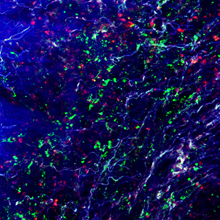Home > Press > Medical nanoparticles: Local treatment of lung cancer
 |
| Tumor tissue in the lung Source: Sabine van Rijt, CPC/iLBD, Helmholtz Zentrum München |
Abstract:
Nanoparticles are extremely small particles that can be modified for a variety of uses in the medical field. For example, nanoparticles can be engineered to be able to transport medicines specifically to the disease site while not interfering with healthy body parts.
Medical nanoparticles: Local treatment of lung cancer
München, Germany | Posted on March 5th, 2015Selective drug transport verified in human tissue for the first time
The Munich scientists have developed nanocarriers that only release the carried drugs in lung tumour areas. The team headed by Silke Meiners, Oliver Eickelberg and Sabine van Rijt from the Comprehensive Pneumology Center (HMGU), working with colleagues from the Chemistry Department (LMU) headed by Thomas Bein, were able to show nanoparticles' selective drug release to human lung tumour tissue for the first time.
Tumour specific proteins were used to release drugs from the nanocarriers
Tumour tissue in the lung contains high concentrations of certain proteases, which are enzymes that break down and cut specific proteins. The scientists took advantage of this by modifying the nanocarriers with a protective layer that only these proteases can break down, a process that then releases the drug. Protease concentrations in the healthy lung tissue are too low to cleave this protective layer and so the medicines stay protected in the nanocarrier.
"Using these nanocarriers we can very selectively release a drug such as a chemotherapeutic agent specifically at the lung tumour," reports research group leader Meiners. "We observed that the drug's effectiveness in the tumour tissue was 10 to 25 times greater compared to when the drugs were used on their own. At the same time, this approach also makes it possible to decrease the total dose of medicines and consequently to reduce undesirable effects."
Further studies will now be directed to examine the safety of the nanocarriers in vivo and verify the clinical efficacy in an advanced lung tumour mouse model.
####
About Helmholtz Zentrum München
As German Research Center for Environmental Health, Helmholtz Zentrum München pursues the goal of developing personalized medical approaches for the prevention and therapy of major common diseases such as diabetes mellitus and lung diseases. To achieve this, it investigates the interaction of genetics, environmental factors and lifestyle. The Helmholtz Zentrum München has about 2,300 staff members and is headquartered in Neuherberg in the north of Munich. Helmholtz Zentrum München is a member of the Helmholtz Association, a community of 18 scientific-technical and medical-biological research centers with a total of about 37,000 staff members. www.helmholtz-muenchen.de
For more information, please click here
Contacts:
PD Dr. Silke Meiners
49-089-318-74673
Copyright © Helmholtz Zentrum München
If you have a comment, please Contact us.Issuers of news releases, not 7th Wave, Inc. or Nanotechnology Now, are solely responsible for the accuracy of the content.
| Related Links |
| Related News Press |
|
|
||
|
|
||
| The latest news from around the world, FREE | ||
|
|
||
|
|
||
| Premium Products | ||
|
|
||
|
Only the news you want to read!
Learn More |
||
|
|
||
|
Full-service, expert consulting
Learn More |
||
|
|
||








